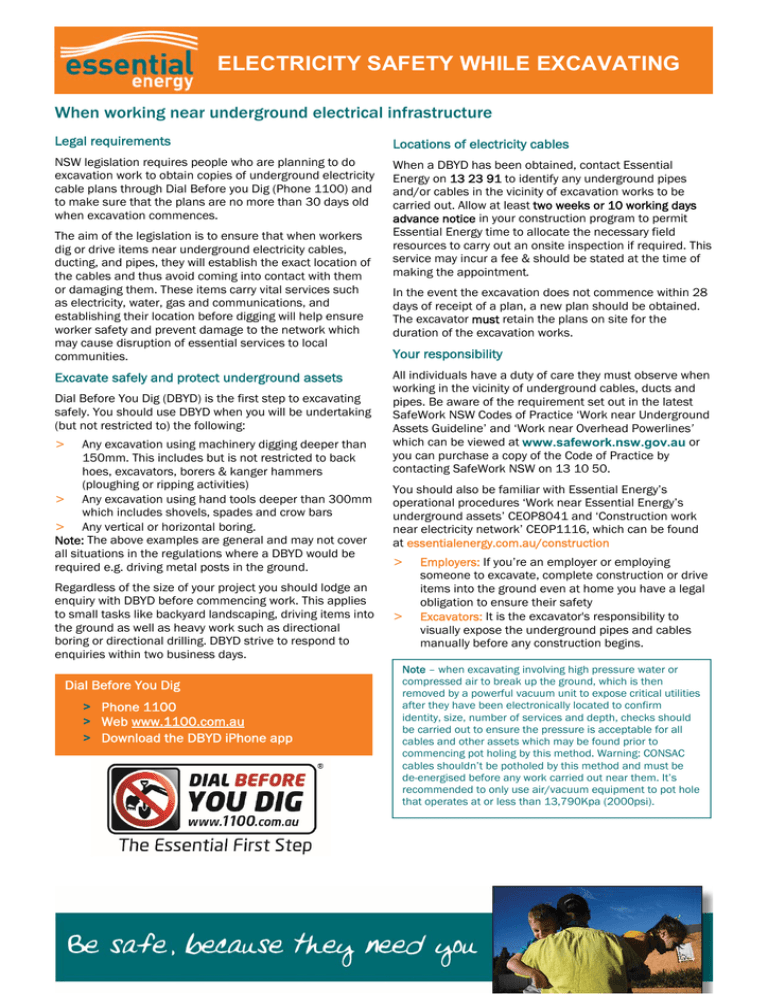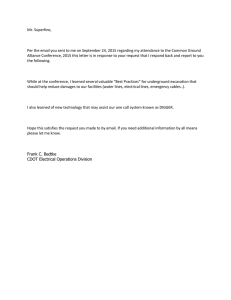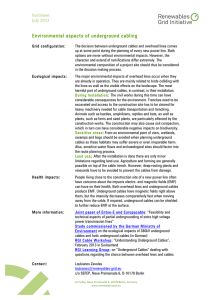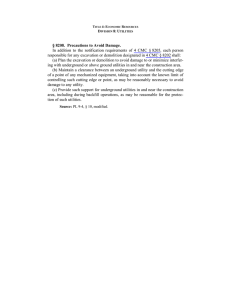electricity safety while excavating
advertisement

ELECTRICITY SAFETY WHILE EXCAVATING When working near underground electrical infrastructure Legal requirements Locations of electricity cables NSW legislation requires people who are planning to do excavation work to obtain copies of underground electricity cable plans through Dial Before you Dig (Phone 1100) and to make sure that the plans are no more than 30 days old when excavation commences. When a DBYD has been obtained, contact Essential Energy on 13 23 91 to identify any underground pipes and/or cables in the vicinity of excavation works to be carried out. Allow at least two weeks or 10 working days advance notice in your construction program to permit Essential Energy time to allocate the necessary field resources to carry out an onsite inspection if required. This service may incur a fee & should be stated at the time of making the appointment. The aim of the legislation is to ensure that when workers dig or drive items near underground electricity cables, ducting, and pipes, they will establish the exact location of the cables and thus avoid coming into contact with them or damaging them. These items carry vital services such as electricity, water, gas and communications, and establishing their location before digging will help ensure worker safety and prevent damage to the network which may cause disruption of essential services to local communities. Excavate safely and protect underground assets Dial Before You Dig (DBYD) is the first step to excavating safely. You should use DBYD when you will be undertaking (but not restricted to) the following: > Any excavation using machinery digging deeper than 150mm. This includes but is not restricted to back hoes, excavators, borers & kanger hammers (ploughing or ripping activities) > Any excavation using hand tools deeper than 300mm which includes shovels, spades and crow bars > Any vertical or horizontal boring. Note: The above examples are general and may not cover all situations in the regulations where a DBYD would be required e.g. driving metal posts in the ground. Regardless of the size of your project you should lodge an enquiry with DBYD before commencing work. This applies to small tasks like backyard landscaping, driving items into the ground as well as heavy work such as directional boring or directional drilling. DBYD strive to respond to enquiries within two business days. Dial Before You Dig > Phone 1100 > Web www.1100.com.au > Download the DBYD iPhone app In the event the excavation does not commence within 28 days of receipt of a plan, a new plan should be obtained. The excavator must retain the plans on site for the duration of the excavation works. Your responsibility All individuals have a duty of care they must observe when working in the vicinity of underground cables, ducts and pipes. Be aware of the requirement set out in the latest SafeWork NSW Codes of Practice ‘Work near Underground Assets Guideline’ and ‘Work near Overhead Powerlines’ which can be viewed at www.safework.nsw.gov.au or you can purchase a copy of the Code of Practice by contacting SafeWork NSW on 13 10 50. You should also be familiar with Essential Energy’s operational procedures ‘Work near Essential Energy’s underground assets’ CEOP8041 and ‘Construction work near electricity network’ CEOP1116, which can be found at essentialenergy.com.au/construction > > Employers: If you’re an employer or employing someone to excavate, complete construction or drive items into the ground even at home you have a legal obligation to ensure their safety Excavators: It is the excavator's responsibility to visually expose the underground pipes and cables manually before any construction begins. Note – when excavating involving high pressure water or compressed air to break up the ground, which is then removed by a powerful vacuum unit to expose critical utilities after they have been electronically located to confirm identity, size, number of services and depth, checks should be carried out to ensure the pressure is acceptable for all cables and other assets which may be found prior to commencing pot holing by this method. Warning: CONSAC cables shouldn’t be potholed by this method and must be de-energised before any work carried out near them. It’s recommended to only use air/vacuum equipment to pot hole that operates at or less than 13,790Kpa (2000psi). No Go Zone for powered excavation Extract from SafeWork NSW “Work near Underground Assets” TABLE 1: Types of assets and limits of underground approach Assets Clearances No Go Zone for Powered Excavation Controls Typical Depths Low voltage electricity cables – voltages less than or equal to 1000V (1kV) Close proximity with the use of hand tools 300 mm Must contact asset owner for specific conditions 450 – 750 mm Electricity conductors from 11,000V (11kV) up to 33,000V (33 kV) Close proximity with the use of hand tools 600 mm Must contact asset owner for specific conditions 900 mm Underground sub-transmission cables 33,000V up to 132,000V (132 kV) Must contact asset owner Must contact asset owner Must be carried out under the supervision of the asset owner 900 mm High Voltage Electricity cables – voltages from 1000V (1kV) up to (33 kV) Close proximity with the use of hand tools Must contact asset owner Must contact asset owner for specific conditions 600 – 1000 mm Extra High Voltage Electricity Transmission cables – voltages above (132 kV) and 330,000V (330 kV) Must contact asset owner Must contact asset owner Work must be carried out under the supervision of the asset owner 800 – 1200 mm How to expose cables or pipes Location plans provide an indication of the presence of underground assets only; they do not pinpoint the exact location. This is why manual exposure is required, which can be done by potholing. Underground assets must first be exposed by pot-holing with non-conductive tools to identify their location. Excavation with hand tools shall be carried out carefully up to, but not closer than, the minimum distances specified in Table 1. Several potholes may need to be dug manually to determine and satisfy yourself of the exact locations of cables or pipes to avoid any mishaps. Manual pot-holing needs to be undertaken with extreme care, common sense and while employing techniques least likely to damage cables. For example, orientate shovel blades and trowels parallel to the cable rather than digging across the cable. Look out for sand, plastic strips or specially marked bricks when excavating, which signal the presence of underground cables. responsibility is to ensure that approach distances from underground and overhead assets are maintained. For boring under electricity cables, the only true way of knowing where the directional drill is, is to “see” it. It is necessary to excavate a slit trench at right angles to the approaching drill and 500mm deeper than the asset being protected and beside the cables to confirm the depth of the cables and ensure the drill is not within the minimum approach distance of the cable (specified in Table 1). For directional boring parallel to the asset and at the level of the asset, a clearance of 500 mm shall be maintained from the edge of the nearest asset and pot holed at 10m intervals to ensure clearances are maintained with a safety observer appointed. The four Ps of safe excavation 1. Only once all underground assets have been located, marked and protected against damage can the excavation proceed with caution. No Go Zone for powered excavation 2. Directional boring is powered excavation and contact with the asset owner must be made before excavation takes place. For directional boring across the line of an asset a minimum clearance of 300 mm from the asset shall be maintained. When boring across the line of an underground asset, the location of the asset/s shall be positively proven by hand digging (pot-holing) or by another approved method and a safety observer appointed. 3. Note: Where the risk assessment identifies a potential risk of making contact with either underground assets, safety observer/s would be required. The safety observer’s 4. Plan – Plan your job. Use the Dial Before You Dig service before your job is due to begin to help keep your project safe. Contact Essential Energy on 13 23 91 to identify any underground pipes and/or cables in the vicinity Pothole – Potholing (digging by hand) is a method to assist in establishing the exact location of all underground infrastructure. Only use air/vacuum equipment to pot hole that operates at or less than 13,790Kpa (2000psi) Protect - Protecting and supporting exposed infrastructure is the excavator’s responsibility. Always erect safety barriers in areas at risk to protect underground networks Proceed – But ONLY when you have planned, potholed and put the protective measures in place. Digging safely You cannot be too careful when it comes to safe excavation. Avoiding underground ducting pipe and cable damage is as simple as having the right tools, the right skills and the right information. > > > > > > > > > > > Study the plans you receive from asset owners thoroughly Check to see if they relate to the area you requested and make sure you understand them. If you are unclear about what the symbols mean or how to proceed, contact the relevant network owner Check the work area for other forms of electrical equipment, including street lights, ground substations, phone boxes or traffic lights – all good indicators that underground cables will be present Remember underground cables can also be present even if overhead powerlines have been identified Never assume the depth or alignment of pipes and cables. Installed networks assets may not have been installed in a straight line Always observe any instructions stated on the plans provided by the asset owner Remember, plans and maps identifying the location of underground cables and depths can alter after road upgrades or developments and underground assets may be as little as a few millimetres below the surface Other service lines (for example gas mains (pipes) and communication cables) can also be present. Shared trenches are frequently used on underground runs to premises New electrical cables are sometimes laid using existing old conduits Various methods of protecting underground cables may be utilised (for example electrical bricks, conduits, concrete or flat PVC barriers) or may be direct buried or installed by under-boring methods which may have no visual disturbance of the ground Ensure overhead & electrical structures aren’t undermined during excavation. Earth cables Earth cables are an important part of all electrical installations and have two main purposes: > > To safeguard against the possibility of danger to life To maintain the good working order of the electrical network. They can have potentially dangerous electrical current flowing through them. Usually they have a green and yellow covering but could be a bare cable buried directly in the ground. Even if the map provided does not show underground cables, earth cables may be present. These earth cables are usually associated with electrical equipment located on the pole such as transformers, switching equipment, permanent earthing points or Padmount / kiosk subs. It’s recommended that if any excavation is to take place within 10m of a power pole with a cable running down it into the ground, contact is made with Essential Energy on 13 23 91 to have the earthing system located. While an effort is made to install the earthing under the powerline and guy if installed, sometimes circumstances may require a variation to this, so done assume where they are installed. The distance and configuration that the earthing cable is installed varies due to the soil conditions and system type (e.g. Single wire earth return (SWER)). Additional earthing electrodes stakes may be installed to ensure the required earthing reading is obtained. WARNING:SWER installations Contacting SWER earthing can be deadly Voltage is present on SWER transformer earthing systems either at 12.7 kV or 19.1kV NO excavation is allowed within 10 metres of a SWER transformer pole. Excavating around electrical poles Anyone intending to excavate around any electrical item risks serious injury or death as a result of contact with underground cables or the earthing system. Assets around poles For excavation depths greater than 250mm near power poles and stays you must arrange for an Essential Energy representative to attend the worksite 2 weeks prior to work commencing. Call Essential Energy on 13 23 91. More information is available in Essential Energy’s operational procedure, ‘Work near Essential Energy’s underground assets: CEOP8041’ which can be found at essentialenergy.com.au/construction Unless otherwise agreed, underground assets and other obstructions around poles are to be kept a minimum distance of 300mm from the periphery of the pole, to allow inspections by the asset owner employees. No excavation within 10 metres of a SWER transformer pole is to occur without the approval of the local electricity asset owner. It should be noted that the NSW Service and Installation Rules require a sketch of the underground service/consumers mains to be marked inside the switchboard. The risks are higher for those earthing systems of the SWER constructions as the earthing is utilised as the return path. Typically any electrical item installed on a pole will have an earth wire running down the pole into the ground, which includes: > > Transformers in urban and rural situations Isolation, protection and regulation items. Transformers located on the ground (padmount and kiosk), besides having underground electrical cables, will have an earthing system installed around them. Emergency situations In the event that contact with an underground powerline occurs or cables are exposed or damaged, remembering the following points could help save a life: > > Damaged earthing If an earth cable has been damaged, maintain a clearance of eight (8) meters and contact Essential Energy on 13 23 91. DONT ATTEMPT to re-join the cable - this will place you at serious risk. Operating near underground cables and earths > > > Underground cables should never be moved or relocated unless under the express authority of the organisation or person responsible for the powerlines The excavator shall report all damage made to Essential Energy assets immediately. Damage includes: gouges, dents, holes and gas escapes Never undermine poles, cables, earthing cable, padmount and kiosk substations. > > > > > > > If the situation is at all life threatening, immediately contact the Emergency Services on 000 (triple zero) Call Essential Energy’s 24-hour supply interruptions line – 13 20 80 to switch off the power if required or report damage or exposure cables / conduits If any other underground assets are damaged you should contact the affected asset owners immediately Treat underground cables as alive, even if they appear to be dead Keep everyone at least eight metres away from the incident site, the person or any machinery making contact with underground cable Don’t panic or touch the person receiving the electric shock – this could place you at risk Untrained, unequipped persons should not attempt to rescue a person receiving an electric shock. All too often secondary deaths occur when others go to the aid of earlier victims Remain on/inside the machinery until the supply is disconnected If possible, break contact between the machinery and underground cable. Above: Poles with become unstable if undermined For more information Make sure it can’t go wrong Essential Energy’s Public Safety team is available to facilitate Electrical Awareness sessions and discuss any questions relating to electrical safety. For more information on electrical safety please call You should ensure that people at work, their equipment (tools and plant) or materials do not come within close proximity to underground powerlines unless: > > A written risk assessment has been completed and a safe system of work implemented The relevant safety precautions and worker training requirements, including SafeWork NSW Codes of Practice and Essential Energy’s requirements, have been implemented and complied with. If working in close proximity to underground cables is unavoidable and the risk assessment has been completed, the following should be considered to control the risks and ensure work safety: > > > Have the power switched off by Essential Energy Consider all conductors as live unless it is positively known they have been de-energised Where appropriate, provide ground markings to identify location and warn workers of the presence of underground power and other assets. General Enquiries 13 23 91 Power outages 13 20 80 SafeWork NSW 13 10 50 Dial Before You Dig www.1100.com.au 1100 Follow us or visit essentialenergy.com.au/safety Safety first: Before you dig or drive items into the ground 1. Contact DBYD 2. DO NOT attempt to excavate with in 10m of any power pole or electrical item 3. Contact Essential Energy on 13 23 91 for assistance to locate cables and earthing 4. Locate asset: Pot-hole 5. Proceed only if you have satisfied yourself it is safe.



